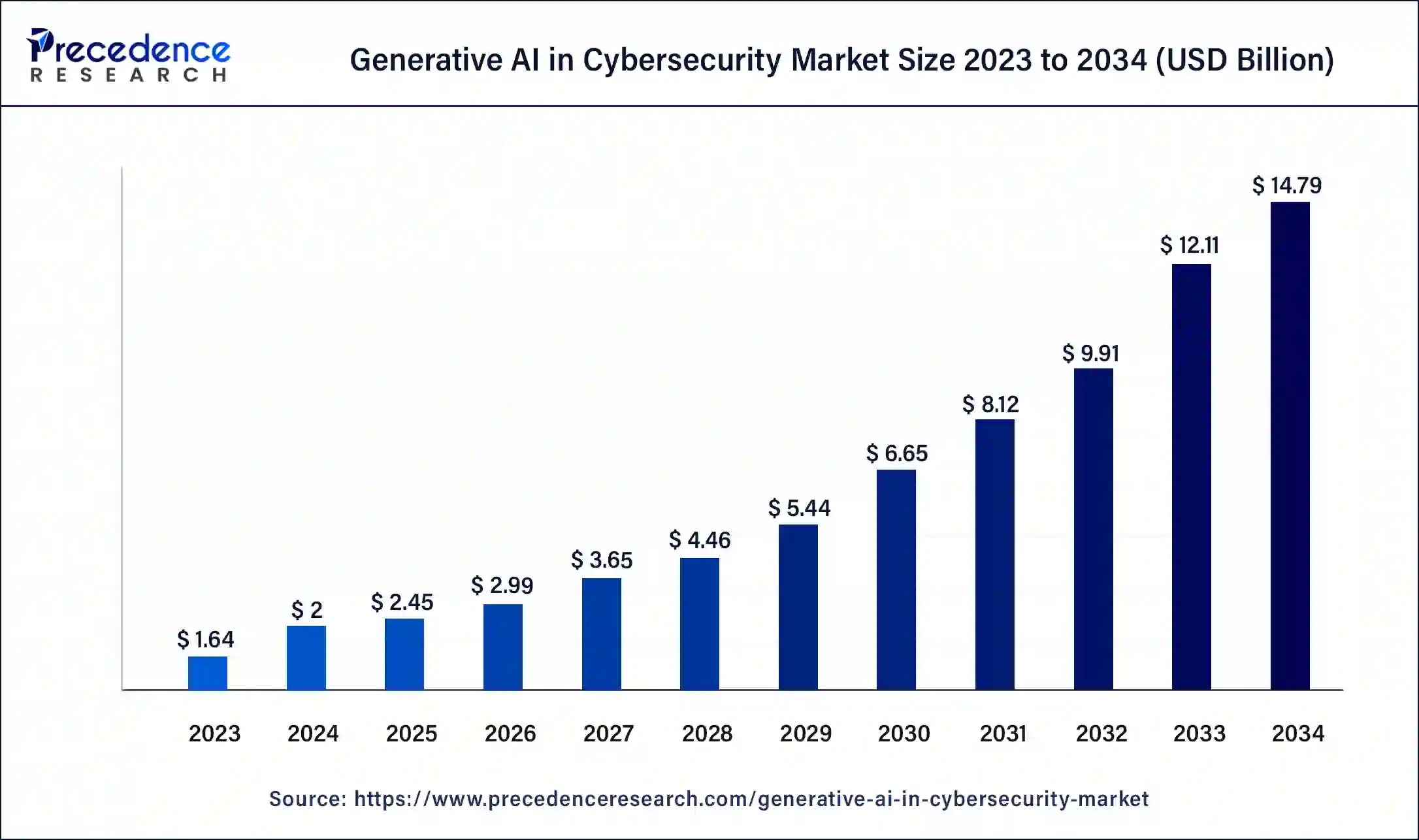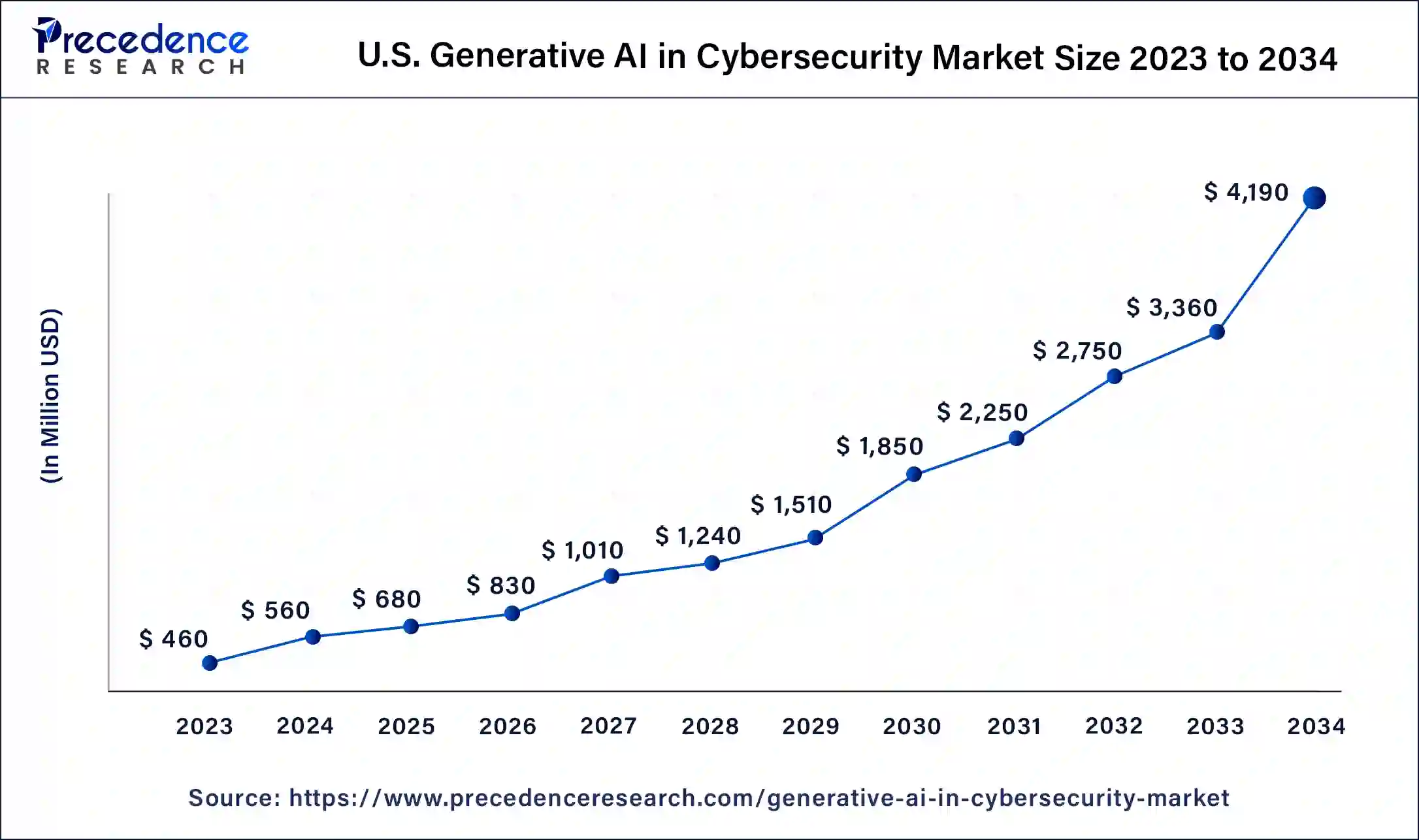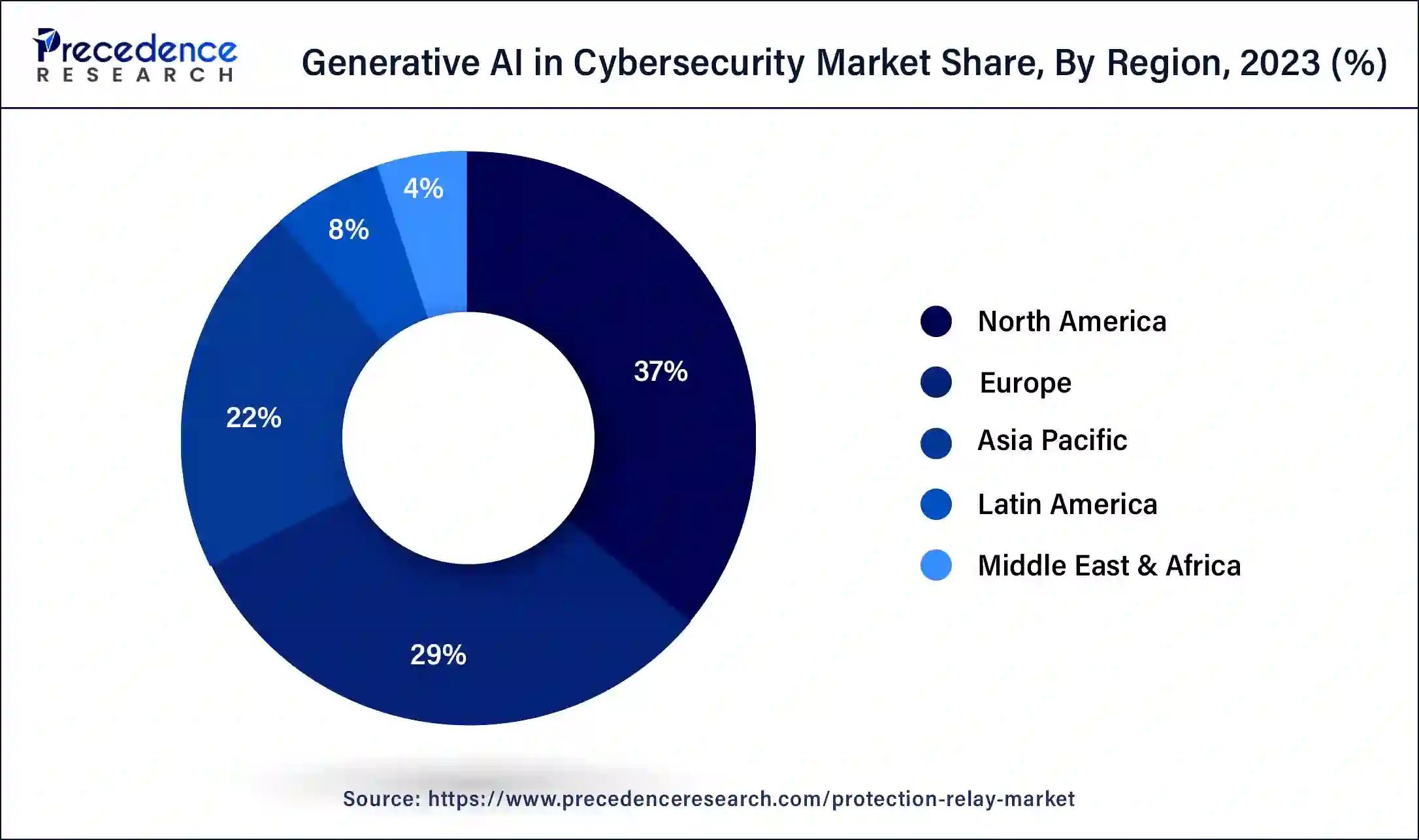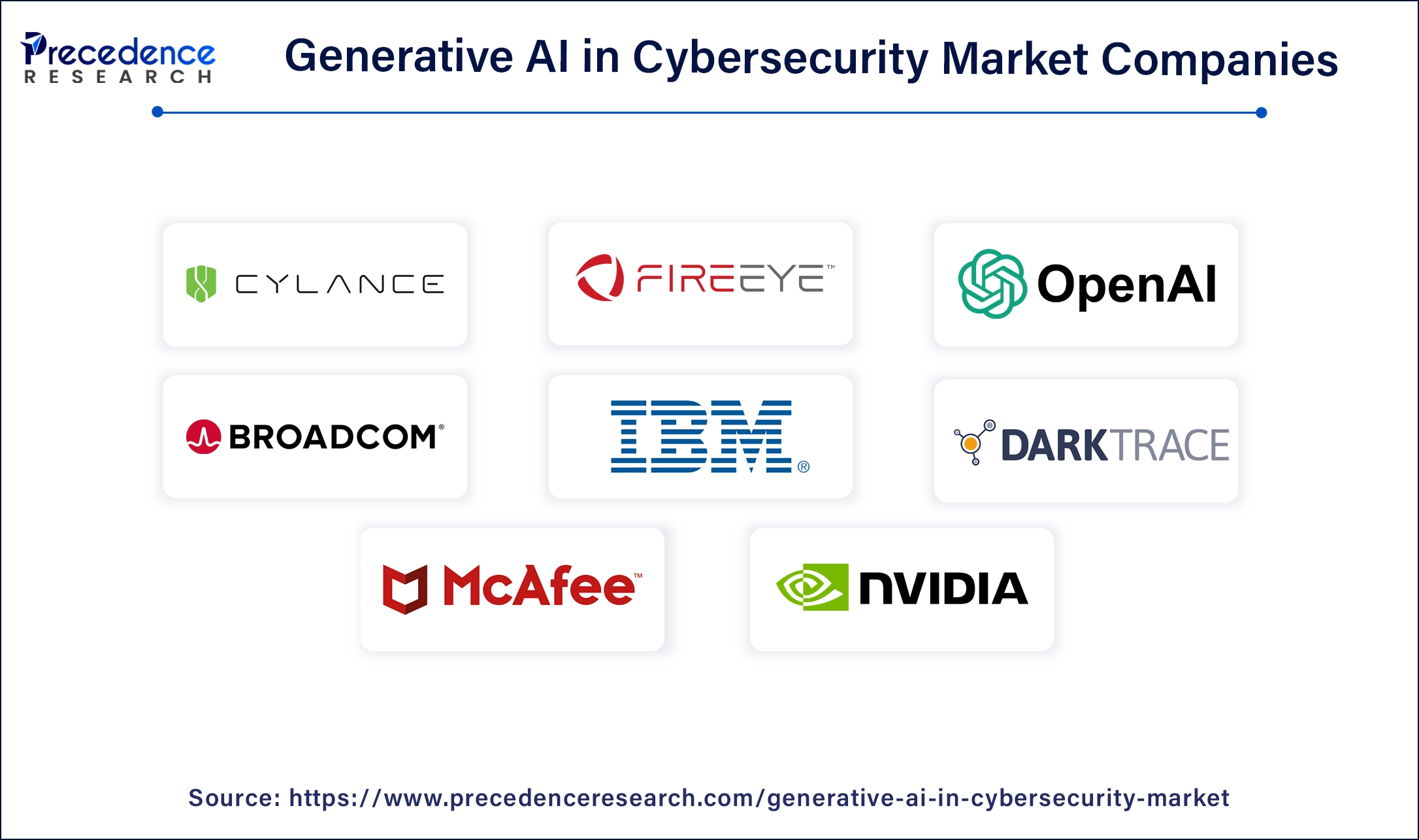January 2025
Generative AI in Cybersecurity Market (By Type: Threat Detection & Analysis, Adversarial Defense, Insider Threat Detection, Network Security, Others; By Technology: Generative Adversarial Networks, Variational Autoencoders, Reinforcement Learning, Deep Neural Networks, Natural Language Processing, Others; By end use) - Global Industry Analysis, Size, Share, Growth, Trends, Regional Outlook, and Forecast 2024-2034
The global generative AI in cybersecurity market size was USD 1.64 billion in 2023, calculated at USD 2 billion in 2024 and is expected to reach around USD 14.79 billion by 2034. The market is expanding at a solid CAGR of 22.13% over the forecast period 2024 to 2034. The North America generative AI in cybersecurity market size reached USD 610 million in 2023. Complex patterns in data can be found and analyzed by generative AI, which enhances the identification of sophisticated cyber threats that conventional techniques might overlook. This drives the growth in the generative AI in cybersecurity market.

The U.S. generative AI in cybersecurity market size was exhibited at USD 460 million in 2023 and is projected to be worth around USD 4,190 million by 2034, poised to grow at a CAGR of 22.24% from 2024 to 2034.

North America held the largest share of the generative AI in cybersecurity market in 2023. Because it may improve threat detection, response capabilities, and overall cybersecurity posture, generative AI is becoming more and more popular in the North American cybersecurity sector. It uses artificial intelligence algorithms to mimic human decision-making processes, assisting with anomaly identification and pattern recognition and even producing countermeasures for possible threats. In situations when standard approaches would not be sufficient to handle the constantly changing panorama of cyber threats, this technology is especially helpful. The development and use of generative AI for cybersecurity applications is greatly aided by North America's status as a center for technical innovation and cybersecurity solutions.

Asia Pacific is expected to host the fastest-growing generative AI in cybersecurity market during the forecast period. The Asia Pacific market for generative AI in cybersecurity is exhibiting considerable development potential. This is being driven by a number of factors, including rising cyber threats, businesses implementing AI-based security solutions, and government efforts to improve cybersecurity. The digital change being embraced by the region's different economies is also driving the need for enhanced cybersecurity solutions. Using AI's capabilities to improve proactive defensive measures, key applications include threat identification, anomaly detection, and automated reaction systems.
Cybersecurity tasks, including anomaly detection, malware identification and analysis, automated penetration testing, threat detection and response, and security analytics, are all performed with the help of generative AI. Deep learning, natural language processing (NLP), and generative adversarial networks are a few of the techniques used to simulate attacks, find trends in cybersecurity data, and strengthen defenses. The necessity for sophisticated defense mechanisms, the complexity of cyberattacks, and the rise in cyber threats are all predicted to drive significant growth in the generative AI in cybersecurity market. With its proactive protection mechanisms and ability to respond to changing cyber threats more quickly, generative AI has the potential to completely change cybersecurity.
Both new and established businesses are creating generative AI solutions for cybersecurity. Their main goal is to incorporate artificial intelligence into current cybersecurity frameworks to enable real-time threat detection and response. Though promising, the generative AI in cybersecurity market confronts obstacles, including the necessity for strong data privacy and security safeguards, the possibility of AI-generated attacks, and ethical considerations. The application of AI to anticipate and stop cyberattacks, the combination of AI with conventional cybersecurity tools, and developments in explainable AI to improve confidence and openness in AI-driven security choices are some future prospects.
| Report Coverage | Details |
| Market Size by 2034 | USD 14.79 Billion |
| Market Size in 2023 | USD 1.64 Billion |
| Market Size in 2024 | USD 2 Billion |
| Market Growth Rate from 2024 to 2034 | CAGR of 22.13% |
| Largest Market | North America |
| Base Year | 2023 |
| Forecast Period | 2024 to 2034 |
| Segments Covered | Type, Technology, end use, and Regions |
| Regions Covered | North America, Europe, Asia-Pacific, Latin America, and Middle East & Africa |
Automation of routine tasks
With its ability to analyze enormous volumes of data, such as system logs, network traffic, and user behavior, AI can automate the detection of possible threats. By starting predetermined procedures like isolating impacted systems, blocking suspicious activity, or notifying cybersecurity professionals, the generative AI in cybersecurity market can help in quickly responding to security problems. The amount of human labor needed for these processes can be decreased by using AI algorithms to automate vulnerability assessments and prioritize remediation operations based on risk assessment. To guarantee ongoing monitoring and compliance, routine processes like log analysis, security policy enforcement, and configuration management can be automated. Based on past data and trends, AI models are able to anticipate possible security breaches, enabling preemptive steps to be taken to stop assaults before they happen.
Ethical implications
The generative AI in cybersecurity market can reinforce biases seen in training data, which could result in discrimination or unjust treatment when making cybersecurity decisions. Large volumes of personal data may be processed by AI algorithms used in cybersecurity, which, if not managed securely, could lead to privacy breaches. It can be difficult to assign blame for AI-generated decisions in cybersecurity situations, particularly when mistakes or harms happen. The transparency standards may be challenged by the opacity of AI algorithms, which might make it challenging for stakeholders to comprehend and audit cybersecurity decisions. Malicious attacks may target AI itself, possibly making use of holes in AI systems to compromise cybersecurity measures. In order to address these ethical issues, laws must be carefully considered, AI methods must be transparent, bias must be mitigated, and strong cybersecurity measures must be in place to protect against threats associated with AI.
Adaptive security measures
Applying artificial intelligence algorithms to examine system and user behavior and spot abnormalities that might point to security vulnerabilities. In order to identify and address risks as they materialize, continuous network traffic monitoring and real-time analysis of application activity and system logs must be performed. Putting in place AI-driven access restrictions that stop illegal access attempts by modifying permissions in response to user behavior and risk profiles. The generative AI in cybersecurity market leverages past security events to enhance their threat detection capabilities and modify defenses accordingly. Automating incident response procedures with AI includes putting questionable files in quarantine, blocking malicious IP addresses, and starting cleanup procedures. Artificial intelligence models that use past data and current patterns to predict possible future attacks, enabling the implementation of proactive security measures.
The threat detection & analysis segment held the largest share of the generative AI in cybersecurity market in 2023. Unusual patterns in user behavior, system logs, or network traffic that can point to a possible threat can be found using AI models. It is possible to teach generative AI algorithms to identify patterns and signs of well-known malware or its variants. Artificial intelligence is able to identify phishing attempts—which often aim to trick users into disclosing sensitive information—by examining emails, URLs, and user interactions. AI is able to recognize typical system or network behavior patterns and notify system administrators of any deviations that might point to malicious activities. AI can forecast possible future risks or weaknesses by evaluating past data and trends. This enables proactive solutions to be implemented.
The network security segment is expected to grow at the fastest rate in the generative AI in cybersecurity market over the forecast period. Network traffic patterns can be analyzed by generative AI models, which can then identify anomalies that might point to possible intrusions or threats. Based on past data, they can also forecast potential attack vectors in the future. Artificial Intelligence can detect anomalies that may indicate unapproved entry or malevolent activity in a network by analyzing the standard behaviors of people and equipment inside it. AI-driven systems offer a proactive protection strategy by constantly adjusting security protocols and defenses in real time based on threats that are discovered. The response time from threat identification to containment or mitigation can be shortened by using generative AI to automate response actions. By spotting suspect login attempts and finding patterns of acceptable user activity, AI can boost authentication systems.
The generative adversarial networks (GANs) segment held the largest share of the generative AI in cybersecurity market in 2023. Cybersecurity researchers are actively examining generative adversarial networks, especially for applications that involve threat and anomaly detection, and they are creating synthetic data for model training. To enhance training datasets for cybersecurity machine learning models, GANs can produce synthetic data that closely resembles real data. In adversarial contexts, where a network (generator) attempts to trick another network (discriminator) by producing realistic data, GANs are used to train models. The robustness of models against adversarial attacks can be strengthened by this adversarial training. In order to facilitate secure data sharing and analysis, GANs can produce synthetic data that protects privacy while maintaining the statistical characteristics of the original data.
The reinforcement learning (RL) segment is expected to grow at the fastest rate in the generative AI in cybersecurity market over the forecast period. By gaining knowledge from interactions with environments, recognizing unusual behaviors, and gradually increasing detection accuracy, reinforcement learning can be used to train models to adapt dynamically to changing threats. By automating decision-making procedures like incident response and mitigation, reinforcement learning enables systems to discover the best ways to respond to cyber threats. By continuously learning and modifying settings based on real-time data and feedback, reinforcement learning algorithms can optimize security policies and guarantee strong defense mechanisms. By learning from past data and current cybersecurity patterns, RL can help optimize risk assessment and management tactics and enhance decision-making under ambiguity. Organizations can test and develop their defenses against prospective cyber-attacks proactively by using simulations driven by reinforcement learning to imitate hostile behaviors.
The banking, financial services, & insurance (BFSI) segment held the largest share of the generative AI in cybersecurity market in 2023. Because of its extreme sensitivity to data security and privacy, the banking, financial services, and insurance (BFSI) industry is a key player in the generative AI in the cybersecurity market. By anticipating possible weaknesses, enhancing incident reaction times, and more efficiently identifying and responding to threats, generative AI might improve cybersecurity in BFSI. It can also help create reliable systems for fraud detection and authentication. The requirement to safeguard confidential financial information and uphold client confidence is what motivates this industry to use generative AI.
The healthcare & life sciences segment is expected to grow at the fastest rate in the generative AI in cybersecurity market over the forecast period. Healthcare institutions handle enormous volumes of private patient information. Strong cybersecurity solutions that shield this data from breaches and unauthorized access can be developed with the aid of generative AI. Clinical trials and pharmaceutical development are just two of the many research activities that are involved in the fields of healthcare and life sciences. It is crucial to defend research data and intellectual property against cyberattacks, and generative AI can strengthen security protocols to do so. Generative AI systems are able to anticipate future attack patterns and learn from previous instances, allowing them to adapt to emerging cyber threats. This ability to adapt is especially helpful in healthcare environments where new vulnerabilities might appear quickly.

Segment Covered in the Report
By Type
By Technology
By End-use
By Geography
For inquiries regarding discounts, bulk purchases, or customization requests, please contact us at sales@precedenceresearch.com
No cookie-cutter, only authentic analysis – take the 1st step to become a Precedence Research client
January 2025
July 2024
September 2024
January 2025